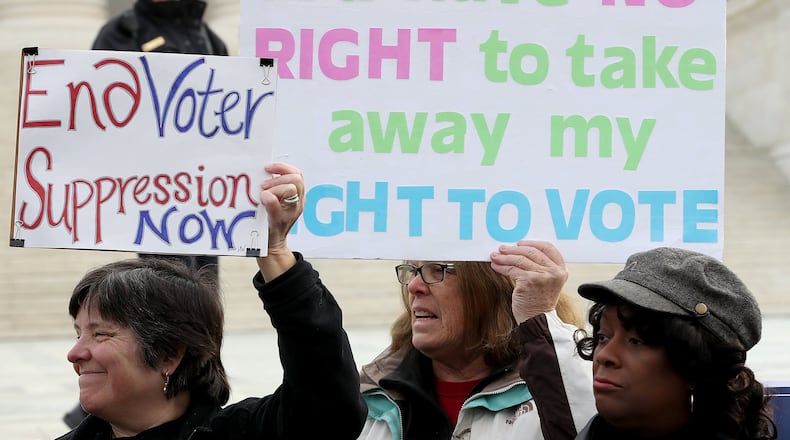Georgia and other states can target people who haven't cast ballots in a while in efforts to purge their voting rolls, the U.S. Supreme Court ruled Monday in an Ohio case that has drawn wide attention amid stark partisan divisions and the approach of the 2018 elections.
By a 5-4 vote that split the conservative and liberal justices, the court rejected arguments that the practice violates a federal law intended to increase the ranks of registered voters. A handful of other states also use voters’ inactivity to trigger a process that could lead to their removal from the voting rolls.
Georgia Secretary of State Brian Kemp said the decision helps protect the accuracy of voter lists.
“This ruling affirms that commonsense measures like Georgia’s voter list maintenance statutes, which prevent fraud at the ballot box, are appropriate and necessary to ensure secure, accessible and fair elections,” said Kemp, who is running in the Republican runoff for governor.
In Georgia, registered voters who fail to vote for three years and then don't respond to a letter from the state are moved to "inactive status." Inactive voters can still participate in elections. Voters who remain inactive for two federal election cycles without voting or having any other contact with election officials are removed from voter rolls.
Ohio’s voting law is similar to Georgia’s, except registered voters in Ohio become ineligible in two years instead of three. Ohio officials said the state only uses the disputed process after first comparing its voter lists with a U.S. Postal Service list of people who have reported a change of address. But not everyone who moves notifies the post office, the state said.
Opponents of this type of voter purge law say it punishes those who exercise their right not to vote.
"This decision does embolden those politicians who are always looking for an excuse to kick people off the rolls," said Sean Young, the legal director for the American Civil Liberties Union of Georgia. "It unreasonably assumes that people who don't vote must have moved, which is ridiculous."
Justice Samuel Alito said for the court that Ohio is complying with the 1993 National Voter Registration Act. He was joined by his four conservative colleagues.
The four liberal justices dissented.
Partisan fights over ballot access are being fought across the country. Democrats have accused Republicans of trying to suppress votes from minorities and poorer people who tend to vote for Democrats. Republicans have said they are trying to promote ballot integrity and prevent voter fraud.
Justice Stephen Breyer, writing in dissent, said the 1993 law prohibits removing someone from the voting rolls “by reason of the person’s failure to vote.”
“In my view, Ohio’s program does just that,” Breyer wrote.
In a separate dissent, Justice Sonia Sotomayor said Congress enacted the voter registration law “against the backdrop of substantial efforts by states to disenfranchise low-income and minority voters.” The court’s decision essentially endorses “the very purging that Congress expressly sought to protect against,” Sotomayor wrote.
Ohio has used voters’ inactivity to trigger the removal process since 1994, although groups representing voters did not sue the Republican secretary of state, Jon Husted, until 2016. As part of the lawsuit, a judge last year ordered the state to count 7,515 ballots cast by people whose names had been removed from the voter rolls.
Husted called the decision “a victory for electoral integrity.” He is running for lieutenant governor this November on the Republican ticket headed by Mike DeWine, the current attorney general.
A three-judge panel on the Cincinnati-based 6th U.S. Circuit Court of Appeals had ruled 2-1 that Ohio’s practice was illegal.
— The Associated Press contributed to this article.
About the Author
Keep Reading
The Latest
Featured





